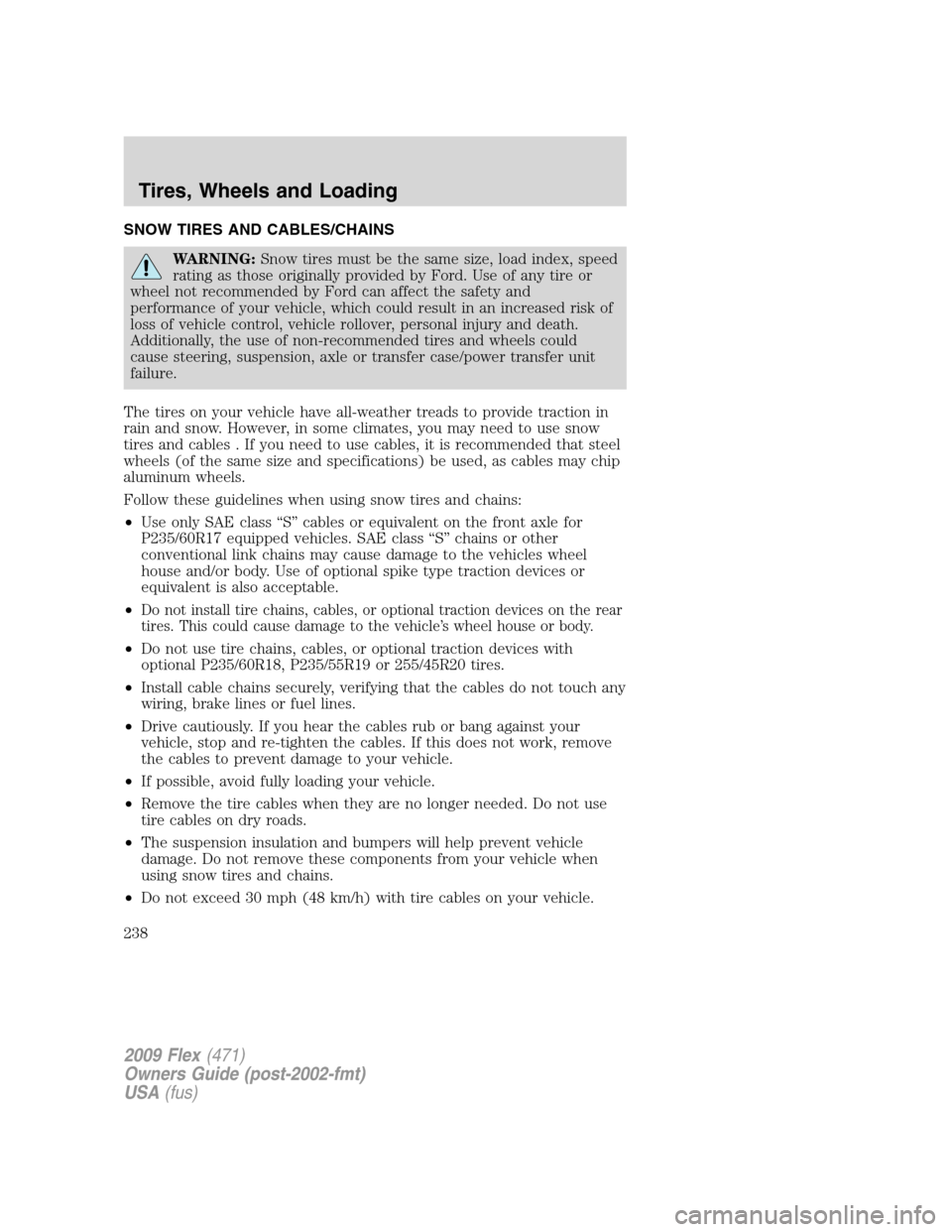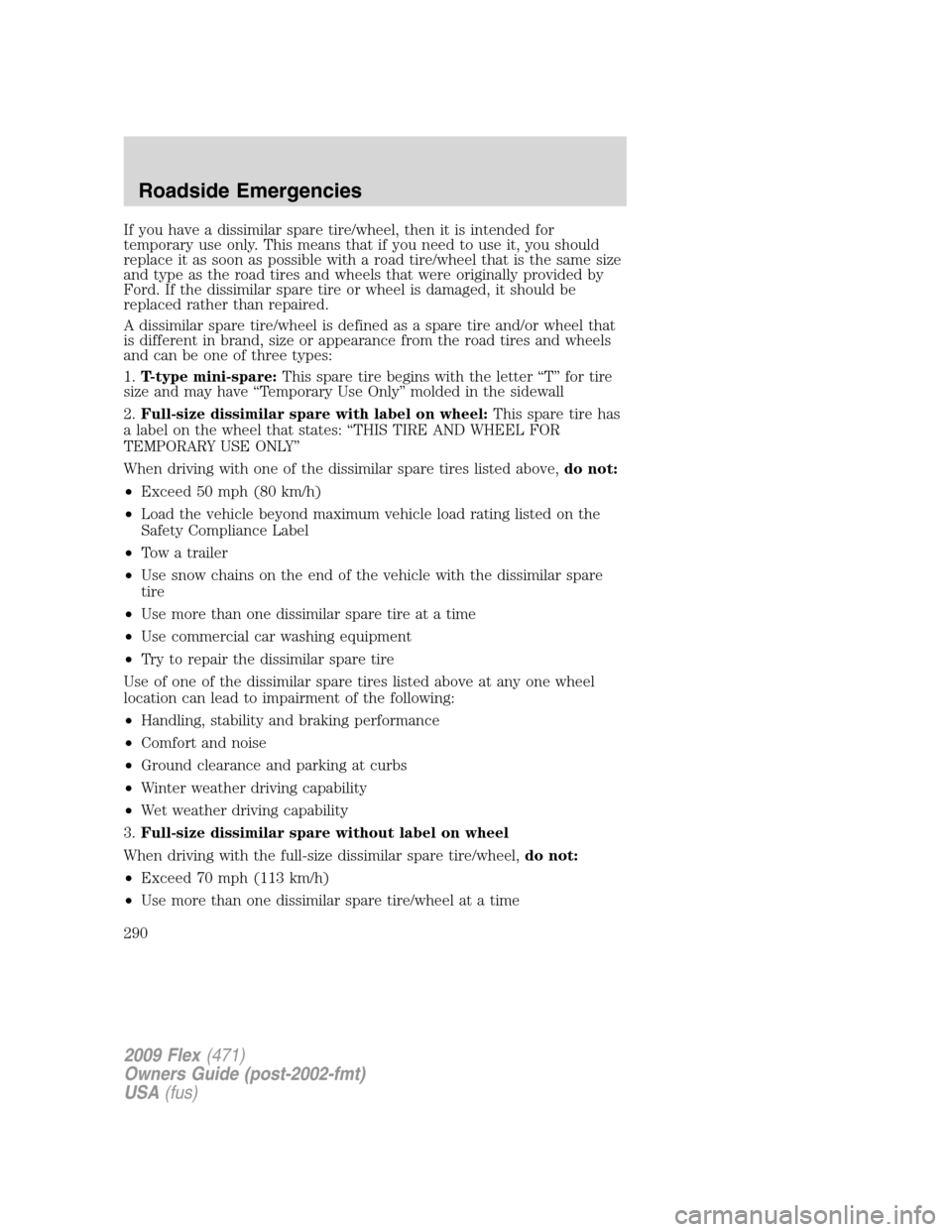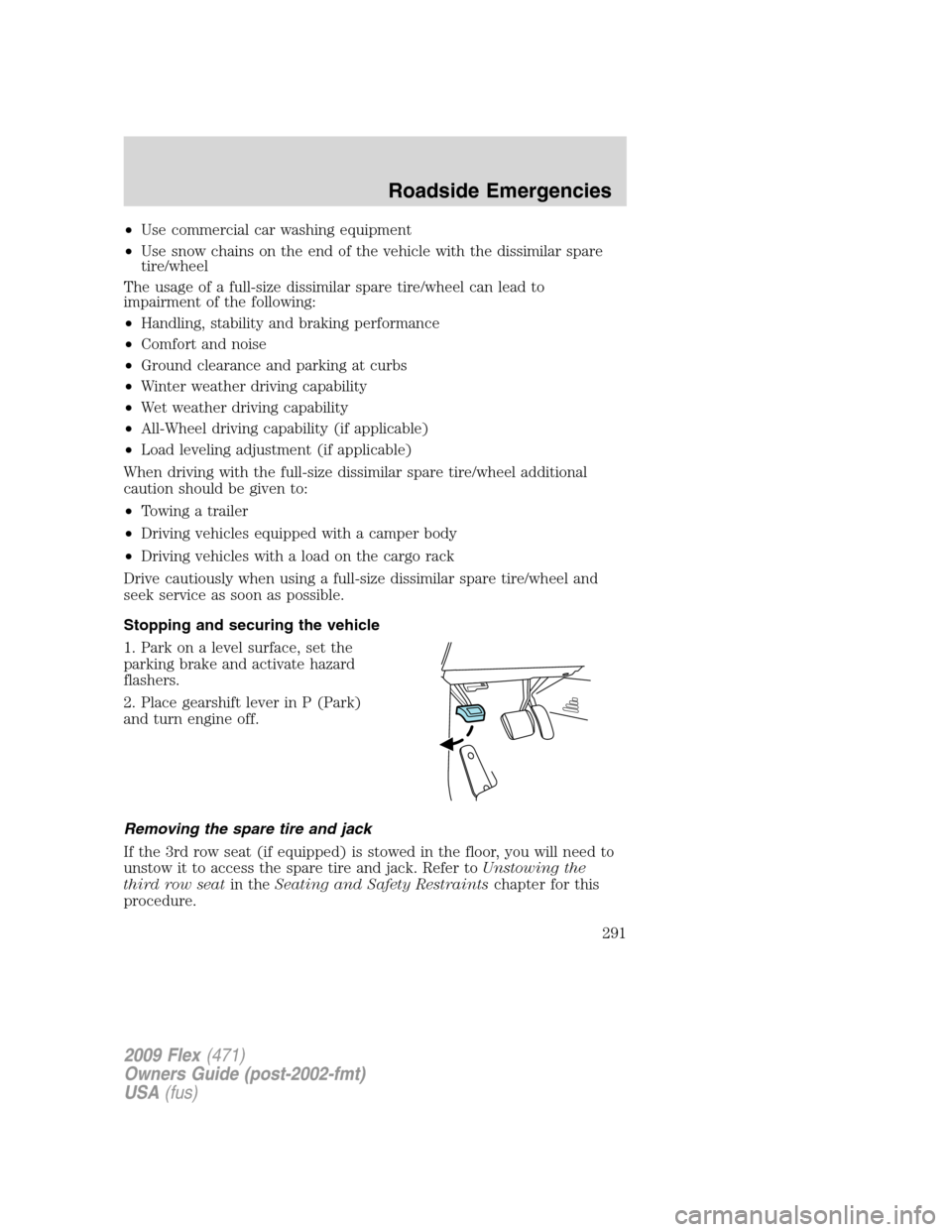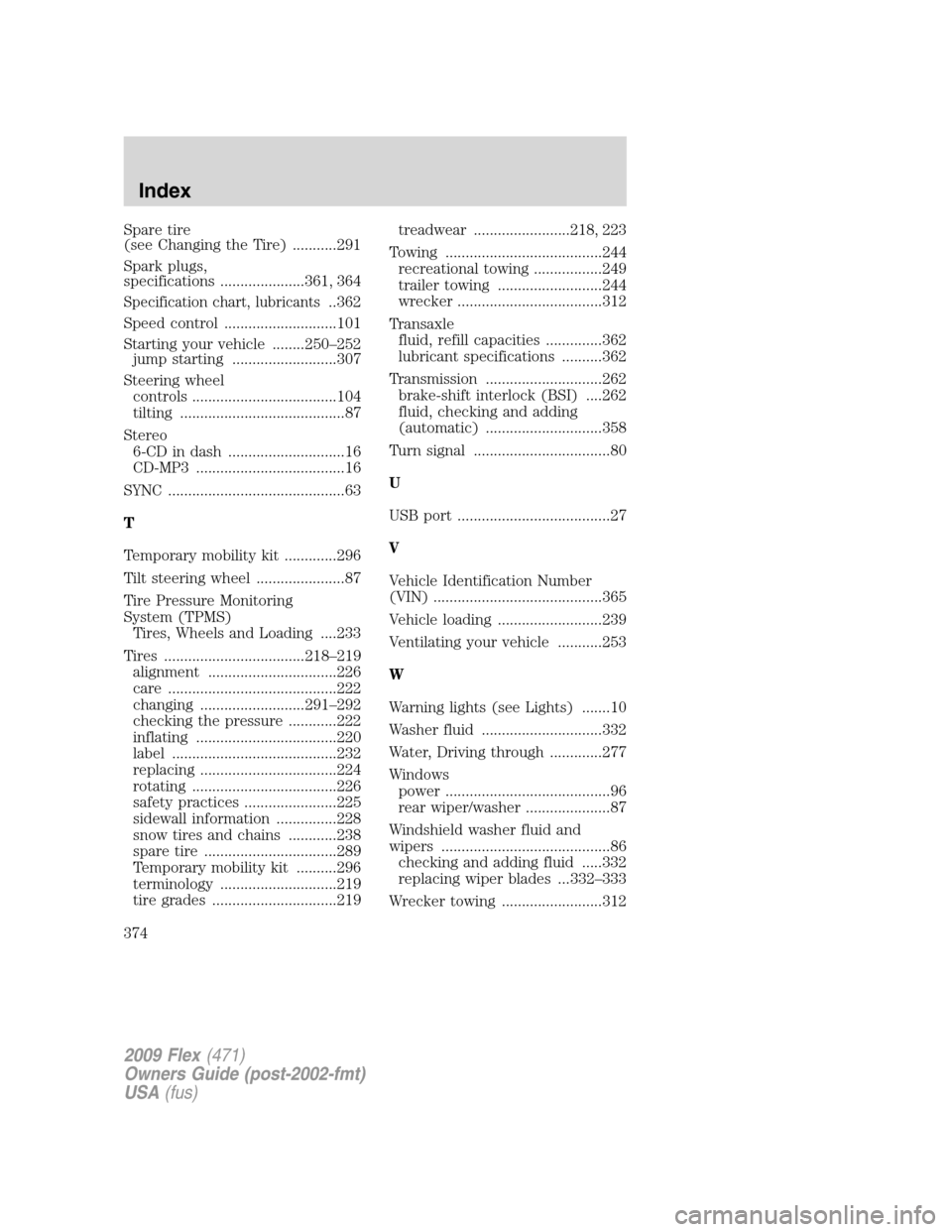snow chains FORD FLEX 2009 1.G Owners Manual
[x] Cancel search | Manufacturer: FORD, Model Year: 2009, Model line: FLEX, Model: FORD FLEX 2009 1.GPages: 374
Page 238 of 374

SNOW TIRES AND CABLES/CHAINS
WARNING:Snow tires must be the same size, load index, speed
rating as those originally provided by Ford. Use of any tire or
wheel not recommended by Ford can affect the safety and
performance of your vehicle, which could result in an increased risk of
loss of vehicle control, vehicle rollover, personal injury and death.
Additionally, the use of non-recommended tires and wheels could
cause steering, suspension, axle or transfer case/power transfer unit
failure.
The tires on your vehicle have all-weather treads to provide traction in
rain and snow. However, in some climates, you may need to use snow
tires and cables . If you need to use cables, it is recommended that steel
wheels (of the same size and specifications) be used, as cables may chip
aluminum wheels.
Follow these guidelines when using snow tires and chains:
•Use only SAE class “S” cables or equivalent on the front axle for
P235/60R17 equipped vehicles. SAE class “S” chains or other
conventional link chains may cause damage to the vehicles wheel
house and/or body. Use of optional spike type traction devices or
equivalent is also acceptable.
•
Do not install tire chains, cables, or optional traction devices on the rear
tires. This could cause damage to the vehicle’s wheel house or body.
•Do not use tire chains, cables, or optional traction devices with
optional P235/60R18, P235/55R19 or 255/45R20 tires.
•Install cable chains securely, verifying that the cables do not touch any
wiring, brake lines or fuel lines.
•Drive cautiously. If you hear the cables rub or bang against your
vehicle, stop and re-tighten the cables. If this does not work, remove
the cables to prevent damage to your vehicle.
•If possible, avoid fully loading your vehicle.
•Remove the tire cables when they are no longer needed. Do not use
tire cables on dry roads.
•The suspension insulation and bumpers will help prevent vehicle
damage. Do not remove these components from your vehicle when
using snow tires and chains.
•Do not exceed 30 mph (48 km/h) with tire cables on your vehicle.
2009 Flex(471)
Owners Guide (post-2002-fmt)
USA(fus)
Tires, Wheels and Loading
238
Page 290 of 374

If you have a dissimilar spare tire/wheel, then it is intended for
temporary use only. This means that if you need to use it, you should
replace it as soon as possible with a road tire/wheel that is the same size
and type as the road tires and wheels that were originally provided by
Ford. If the dissimilar spare tire or wheel is damaged, it should be
replaced rather than repaired.
A dissimilar spare tire/wheel is defined as a spare tire and/or wheel that
is different in brand, size or appearance from the road tires and wheels
and can be one of three types:
1.T-type mini-spare:This spare tire begins with the letter “T” for tire
size and may have “Temporary Use Only” molded in the sidewall
2.Full-size dissimilar spare with label on wheel:This spare tire has
a label on the wheel that states: “THIS TIRE AND WHEEL FOR
TEMPORARY USE ONLY”
When driving with one of the dissimilar spare tires listed above,do not:
•Exceed 50 mph (80 km/h)
•Load the vehicle beyond maximum vehicle load rating listed on the
Safety Compliance Label
•Tow a trailer
•Use snow chains on the end of the vehicle with the dissimilar spare
tire
•Use more than one dissimilar spare tire at a time
•Use commercial car washing equipment
•Try to repair the dissimilar spare tire
Use of one of the dissimilar spare tires listed above at any one wheel
location can lead to impairment of the following:
•Handling, stability and braking performance
•Comfort and noise
•Ground clearance and parking at curbs
•Winter weather driving capability
•Wet weather driving capability
3.Full-size dissimilar spare without label on wheel
When driving with the full-size dissimilar spare tire/wheel,do not:
•Exceed 70 mph (113 km/h)
•Use more than one dissimilar spare tire/wheel at a time
2009 Flex(471)
Owners Guide (post-2002-fmt)
USA(fus)
Roadside Emergencies
290
Page 291 of 374

•Use commercial car washing equipment
•Use snow chains on the end of the vehicle with the dissimilar spare
tire/wheel
The usage of a full-size dissimilar spare tire/wheel can lead to
impairment of the following:
•Handling, stability and braking performance
•Comfort and noise
•Ground clearance and parking at curbs
•Winter weather driving capability
•Wet weather driving capability
•All-Wheel driving capability (if applicable)
•Load leveling adjustment (if applicable)
When driving with the full-size dissimilar spare tire/wheel additional
caution should be given to:
•Towing a trailer
•Driving vehicles equipped with a camper body
•Driving vehicles with a load on the cargo rack
Drive cautiously when using a full-size dissimilar spare tire/wheel and
seek service as soon as possible.
Stopping and securing the vehicle
1. Park on a level surface, set the
parking brake and activate hazard
flashers.
2. Place gearshift lever in P (Park)
and turn engine off.
Removing the spare tire and jack
If the 3rd row seat (if equipped) is stowed in the floor, you will need to
unstow it to access the spare tire and jack. Refer toUnstowing the
third row seatin theSeating and Safety Restraintschapter for this
procedure.
2009 Flex(471)
Owners Guide (post-2002-fmt)
USA(fus)
Roadside Emergencies
291
Page 374 of 374

Spare tire
(see Changing the Tire) ...........291
Spark plugs,
specifications .....................361, 364
Specification chart, lubricants..362
Speed control ............................101
Starting your vehicle ........250–252
jump starting ..........................307
Steering wheel
controls ....................................104
tilting .........................................87
Stereo
6-CD in dash .............................16
CD-MP3 .....................................16
SYNC ............................................63
T
Temporary mobility kit .............296
Tilt steering wheel ......................87
Tire Pressure Monitoring
System (TPMS)
Tires, Wheels and Loading ....233
Tires ...................................218–219
alignment ................................226
care ..........................................222
changing ..........................291–292
checking the pressure ............222
inflating ...................................220
label .........................................232
replacing ..................................224
rotating ....................................226
safety practices .......................225
sidewall information ...............228
snow tires and chains ............238
spare tire .................................289
Temporary mobility kit ..........296
terminology .............................219
tire grades ...............................219treadwear ........................218, 223
Towing .......................................244
recreational towing .................249
trailer towing ..........................244
wrecker ....................................312
Transaxle
fluid, refill capacities ..............362
lubricant specifications ..........362
Transmission .............................262
brake-shift interlock (BSI) ....262
fluid, checking and adding
(automatic) .............................358
Turn signal ..................................80
U
USB port ......................................27
V
Vehicle Identification Number
(VIN) ..........................................365
Vehicle loading ..........................239
Ventilating your vehicle ...........253
W
Warning lights (see Lights) .......10
Washer fluid ..............................332
Water, Driving through .............277
Windows
power .........................................96
rear wiper/washer .....................87
Windshield washer fluid and
wipers ..........................................86
checking and adding fluid .....332
replacing wiper blades ...332–333
Wrecker towing .........................312
2009 Flex(471)
Owners Guide (post-2002-fmt)
USA(fus)
Index
374